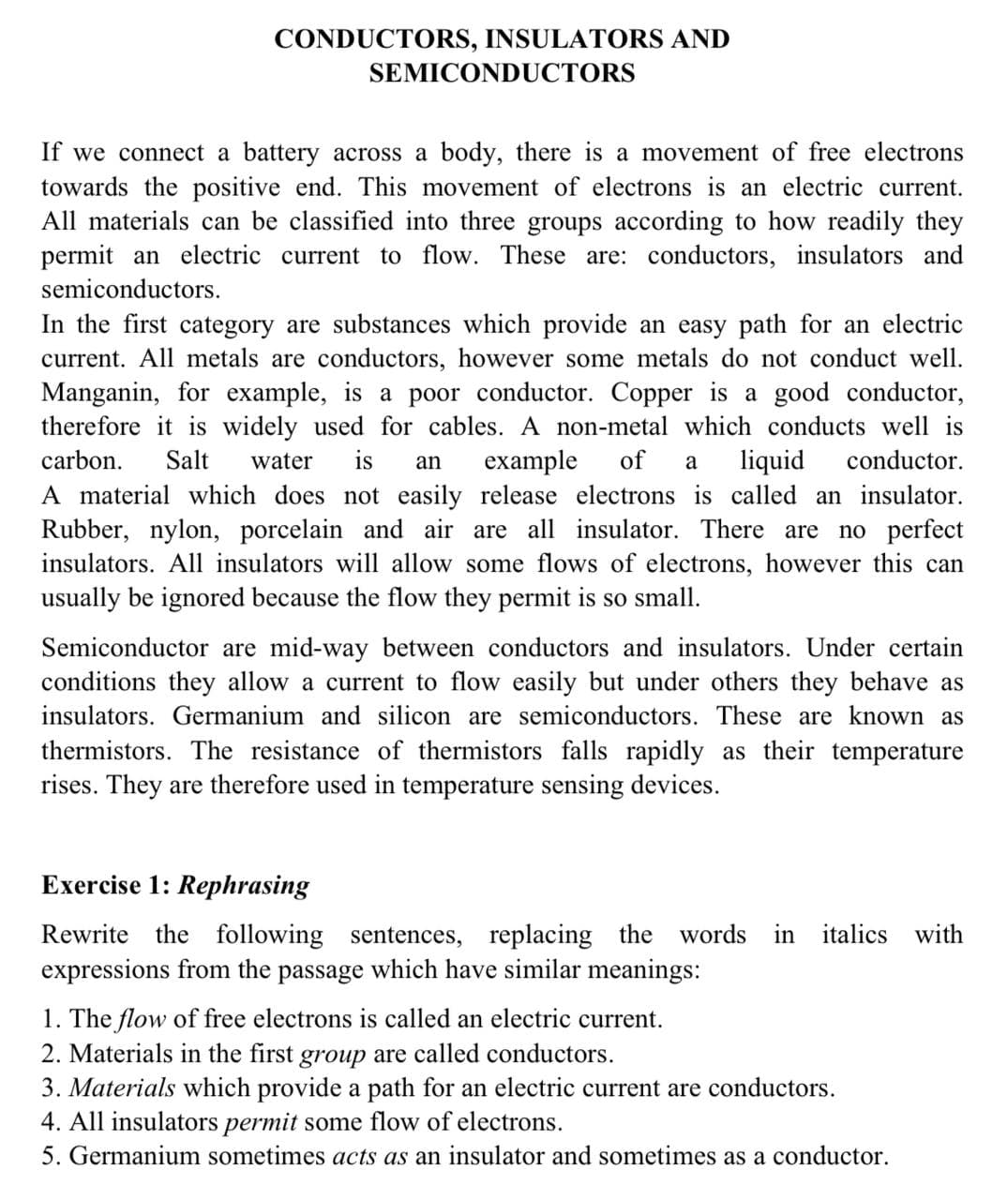CONDUCTORS, INSULATORS AND SEMICONDUCTORS If we connect a battery across a body, there is a movement of free electrons towards the positive end. This movement of electrons is an electric current. All materials can be classified into three groups according to how readily they permit an electric current to flow. These are: conductors, insulators and semiconductors. In the first category are substances which provide an easy path for an electric current. All metals are conductors, however some metals do not conduct well. Manganin, for example, is a poor conductor. Copper is a good conductor, therefore it is widely used for cables. A non-metal which conducts well is carbon. Salt water is example of liquid conductor. an a A material which does not easily release electrons is called an insulator. Rubber, nylon, porcelain and air are all insulator. There are insulators. All insulators will allow some flows of electrons, however this can usually be ignored because the flow they permit is so small. no perfect Semiconductor are mid-way between conductors and insulators. Under certain conditions they allow a current to flow easily but under others they behave as insulators. Germanium and silicon are semiconductors. These are known as thermistors. The resistance of thermistors falls rapidly as their temperature rises. They are therefore used in temperature sensing devices. Exercise 1: Rephrasing Rewrite the following sentences, replacing the words in italics with expressions from the passage which have similar meanings: 1. The flow of free electrons is called an electric current. 2. Materials in the first group are called conductors. 3. Materials which provide a path for an electric current are conductors. 4. All insulators permit some flow of electrons. 5. Germanium sometimes acts as an insulator and sometimes as a conductor.
CONDUCTORS, INSULATORS AND SEMICONDUCTORS If we connect a battery across a body, there is a movement of free electrons towards the positive end. This movement of electrons is an electric current. All materials can be classified into three groups according to how readily they permit an electric current to flow. These are: conductors, insulators and semiconductors. In the first category are substances which provide an easy path for an electric current. All metals are conductors, however some metals do not conduct well. Manganin, for example, is a poor conductor. Copper is a good conductor, therefore it is widely used for cables. A non-metal which conducts well is carbon. Salt water is example of liquid conductor. an a A material which does not easily release electrons is called an insulator. Rubber, nylon, porcelain and air are all insulator. There are insulators. All insulators will allow some flows of electrons, however this can usually be ignored because the flow they permit is so small. no perfect Semiconductor are mid-way between conductors and insulators. Under certain conditions they allow a current to flow easily but under others they behave as insulators. Germanium and silicon are semiconductors. These are known as thermistors. The resistance of thermistors falls rapidly as their temperature rises. They are therefore used in temperature sensing devices. Exercise 1: Rephrasing Rewrite the following sentences, replacing the words in italics with expressions from the passage which have similar meanings: 1. The flow of free electrons is called an electric current. 2. Materials in the first group are called conductors. 3. Materials which provide a path for an electric current are conductors. 4. All insulators permit some flow of electrons. 5. Germanium sometimes acts as an insulator and sometimes as a conductor.
Related questions
Question
i need the answer quickly

Transcribed Image Text:CONDUCTORS, INSULATORS AND
SEMICONDUCTORS
If we connect a battery across a body, there is a movement of free electrons
towards the positive end. This movement of electrons is an electric current.
All materials can be classified into three groups according to how readily they
permit an electric current to flow. These are: conductors, insulators and
semiconductors.
In the first category are substances which provide an easy path for an electric
current. All metals are conductors, however some metals do not conduct well.
Manganin, for example, is a poor conductor. Copper is a good conductor,
therefore it is widely used for cables. A non-metal which conducts well is
carbon.
Salt
water
is
example
of
liquid
conductor.
an
a
A material which does not easily release electrons is called an insulator.
Rubber, nylon, porcelain and air are all insulator. There are no perfect
insulators. All insulators will allow some flows of electrons, however this can
usually be ignored because the flow they permit is so small.
Semiconductor are mid-way between conductors and insulators. Under certain
conditions they allow a current to flow easily but under others they behave as
insulators. Germanium and silicon are semiconductors. These are known as
thermistors. The resistance of thermistors falls rapidly as their temperature
rises. They are therefore used in temperature sensing devices.
Exercise 1: Rephrasing
Rewrite the following sentences, replacing the words
expressions from the passage which have similar meanings:
in italics with
1. The flow of free electrons is called an electric current.
2. Materials in the first group are called conductors.
3. Materials which provide a path for an electric current are conductors.
4. All insulators permit some flow of electrons.
5. Germanium sometimes acts as an insulator and sometimes as a conductor.
Expert Solution
This question has been solved!
Explore an expertly crafted, step-by-step solution for a thorough understanding of key concepts.
This is a popular solution!
Trending now
This is a popular solution!
Step by step
Solved in 2 steps
